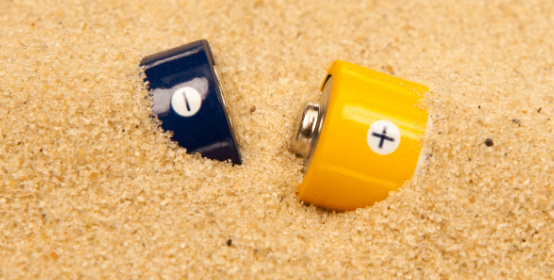
Ever since its inception, green energy has had one major drawback: storage. Current battery technology isn't very efficient, and heavily relies on minerals that are often sourced unethically and unsustainably. “Sand batteries” could potentially change all of that, but are they all they're cracked up to be?
Sand batteries are pretty much exactly what they sound like—batteries that use sand to store energy. In this case, they store power as heat.
The process goes like this: First, cheap power is generated by wind turbines or solar arrays. Some of this is used at the time, sent directly to power homes and businesses. The surplus is used to heat cheap, low-grade sand through resistive heating. A heat exchanger circulates hot air through the sand.
Sand is mostly quartz. Quartz has a very high melting point (1667 °C) and is very efficient at transferring heat. In a sand battery, the sand stores the heat at up to 1000 °C for several months at a time. In winter, the sand can be used to heat water which then goes to keep homes warm.
In this sense, the word “sand battery” is a bit of a misnomer. They're not actually storing electricity, or even storing chemical energy like a conventional battery. They're more like a very effective means of long-term thermal storage. Nonetheless, this simple fact can still revolutionize clean energy.
At the moment, most clean energy relies on lithium batteries. These batteries are big, expensive, and somewhat limited when it comes to handling excess electricity.
Lithium mining has also come under a lot of scrutiny. The majority of it comes from either igneous rock, or lithium carbonate reserves in subsurface water beneath salt deserts called salars. Obtaining lithium from either of these sources requires a lot of water and emits a considerable amount of carbon dioxide. Some lithium mines have been found to use forced child labor, and there are complaints that obtaining lithium from salars leads to increased drought in vulnerable areas.
Lithium-ion batteries also degrade over time. While lithium ions were once thought to move in predictable patterns, research has shown that this isn't the case. Instead, it can move in ways that create “hot spots” within batteries and cause damage. The end result is a battery with a limited lifespan.
Sand batteries, on the other hand, don't share many of these problems. They use low-grade builder's sand packed into a silo. It's an elegantly low-tech solution to a complex, high-tech problem.
They're also already successfully used in Finland. The Vatajankoski power plant in the town of Kankaanpää already has a working sand battery that helps serve the district's heating needs. Now, even more countries around the world are taking notice. In the US, the National Renewable Energy Laboratory (NREL) is researching ways to adapt and improve upon the sand battery's base concept.
Sand batteries have a lot going for them. They're not super complicated, don't require exotic minerals, and can be deployed relatively quickly, easily, and inexpensively. If an accident occurs, the worst that happens is wasted heat. Even if a silo were to rupture, the damage would just involve having to clean up a bunch of hot sand. There wouldn't be long-term pollution to worry about.
The heat from sand batteries could also be used for industrial processes that currently rely on heating elements powered by fossil fuels. This could drastically reduce the non-renewable power consumption of factories that produce food, beverages, or textiles, for example.
That said, there are reasons why sand batteries aren't popping up everywhere. If they sound a bit too good to be true, it's because they still have some downsides.
The chief issue right now is that sand is great at storing heat, but that's pretty much it. While sand batteries are a great solution for places that experience cold winters and use a considerable amount of power to heat buildings during the cold months, they're not quite as helpful in other contexts.
Getting electricity back from a sand battery is fairly straightforward—use the stored heat to heat water, then use the resulting steam to power a steam turbine. The only problem is that this is a very inefficient process that would only yield about 20% of the stored power as electricity. That makes sand batteries pretty difficult to scale for more widespread use.
Will sand batteries change the way we use clean energy? For many of us, they just might. This technology could allow temperate regions to greatly reduce their heating fuel needs by providing an inexpensive way to use summer sun and wind to keep homes warm. It could also help factories cut way back on the fuel consumed to heat important industrial processes. Though it's not very efficient to turn a sand battery's heat back into electricity yet, they can still be a valuable part of a well-planned renewable energy grid.